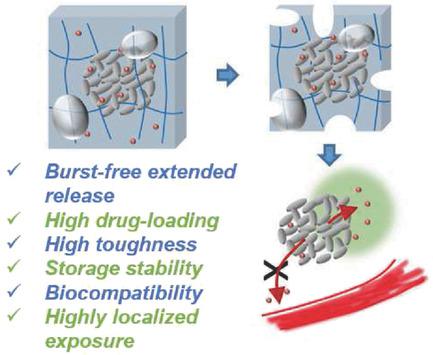当前位置:
X-MOL 学术
›
Adv. Healthcare Mater.
›
论文详情
Our official English website, www.x-mol.net, welcomes your feedback! (Note: you will need to create a separate account there.)
Tough Composite Hydrogels with High Loading and Local Release of Biological Drugs
Advanced Healthcare Materials ( IF 10.0 ) Pub Date : 2018-02-14 , DOI: 10.1002/adhm.201701393 Jianyu Li 1, 2, 3 , Eckhard Weber 4 , Sabine Guth‐Gundel 4 , Michael Schuleit 4 , Andreas Kuttler 4 , Christine Halleux 4 , Nathalie Accart 4 , Arno Doelemeyer 4 , Anne Basler 4 , Bruno Tigani 4 , Kuno Wuersch 4 , Mara Fornaro 4 , Michaela Kneissel 4 , Alexander Stafford 1, 2 , Benjamin R. Freedman 1, 2 , David J. Mooney 1, 2
Advanced Healthcare Materials ( IF 10.0 ) Pub Date : 2018-02-14 , DOI: 10.1002/adhm.201701393 Jianyu Li 1, 2, 3 , Eckhard Weber 4 , Sabine Guth‐Gundel 4 , Michael Schuleit 4 , Andreas Kuttler 4 , Christine Halleux 4 , Nathalie Accart 4 , Arno Doelemeyer 4 , Anne Basler 4 , Bruno Tigani 4 , Kuno Wuersch 4 , Mara Fornaro 4 , Michaela Kneissel 4 , Alexander Stafford 1, 2 , Benjamin R. Freedman 1, 2 , David J. Mooney 1, 2
Affiliation

|
Hydrogels are under active development for controlled drug delivery, but their clinical translation is limited by low drug loading capacity, deficiencies in mechanical toughness and storage stability, and poor control over the drug release that often results in burst release and short release duration. This work reports a design of composite clay hydrogels, which simultaneously achieve a spectrum of mechanical, storage, and drug loading/releasing properties to address the critical needs from translational perspectives. The clay nanoparticles provide large surface areas to adsorb biological drugs, and assemble into microparticles that are physically trapped within and toughen hydrogel networks. The composite hydrogels demonstrate feasibility of storage, and extended release of large quantities of an insulin‐like growth factor‐1 mimetic protein (8 mg mL−1) over four weeks. The release rate is primarily governed by ionic exchange and can be upregulated by low pH, which is typical for injured tissues. A rodent model of Achilles tendon injury is used to demonstrate that the composite hydrogels allow for highly extended and localized release of biological drugs in vivo, while demonstrating biodegradation and biocompatibility. These attributes make the composite hydrogel a promising system for drug delivery and regenerative medicine.
中文翻译:

高负荷和生物药物局部释放的坚韧复合水凝胶
水凝胶正在积极开发以控制药物的输送,但是其临床翻译受到药物载量低,机械韧性和储存稳定性不足以及对药物释放的控制不良(通常导致爆发释放和释放持续时间短)的限制。这项工作报告了复合粘土水凝胶的设计,该设计同时实现了一系列的机械,存储和药物加载/释放特性,从而满足了从平移角度来看的关键需求。粘土纳米颗粒提供了较大的表面积来吸附生物药物,并组装成物理上被困在其中并增韧水凝胶网络的微粒。复合水凝胶证明了储存的可行性,-1)超过四个星期。释放速率主要由离子交换决定,并且可以通过低pH值上调,低pH是受伤组织的典型现象。阿奇里斯腱损伤的啮齿动物模型用于证明复合水凝胶可以在体内高度扩展和局部释放生物药物,同时证明了其生物降解性和生物相容性。这些特性使复合水凝胶成为用于药物输送和再生医学的有前途的系统。
更新日期:2018-02-14
中文翻译:

高负荷和生物药物局部释放的坚韧复合水凝胶
水凝胶正在积极开发以控制药物的输送,但是其临床翻译受到药物载量低,机械韧性和储存稳定性不足以及对药物释放的控制不良(通常导致爆发释放和释放持续时间短)的限制。这项工作报告了复合粘土水凝胶的设计,该设计同时实现了一系列的机械,存储和药物加载/释放特性,从而满足了从平移角度来看的关键需求。粘土纳米颗粒提供了较大的表面积来吸附生物药物,并组装成物理上被困在其中并增韧水凝胶网络的微粒。复合水凝胶证明了储存的可行性,-1)超过四个星期。释放速率主要由离子交换决定,并且可以通过低pH值上调,低pH是受伤组织的典型现象。阿奇里斯腱损伤的啮齿动物模型用于证明复合水凝胶可以在体内高度扩展和局部释放生物药物,同时证明了其生物降解性和生物相容性。这些特性使复合水凝胶成为用于药物输送和再生医学的有前途的系统。


























 京公网安备 11010802027423号
京公网安备 11010802027423号